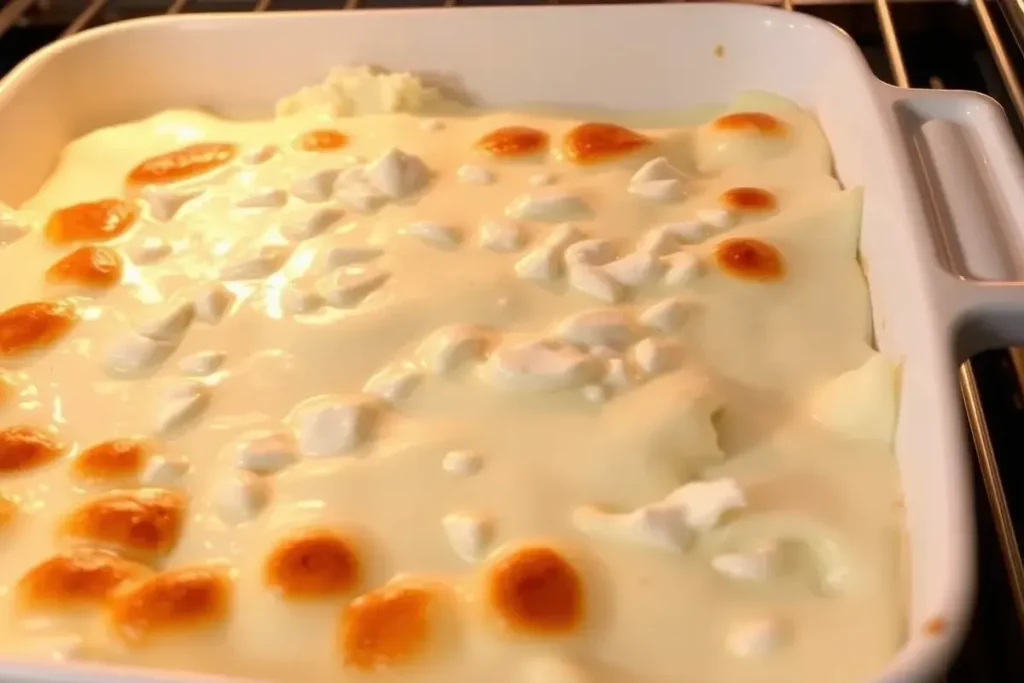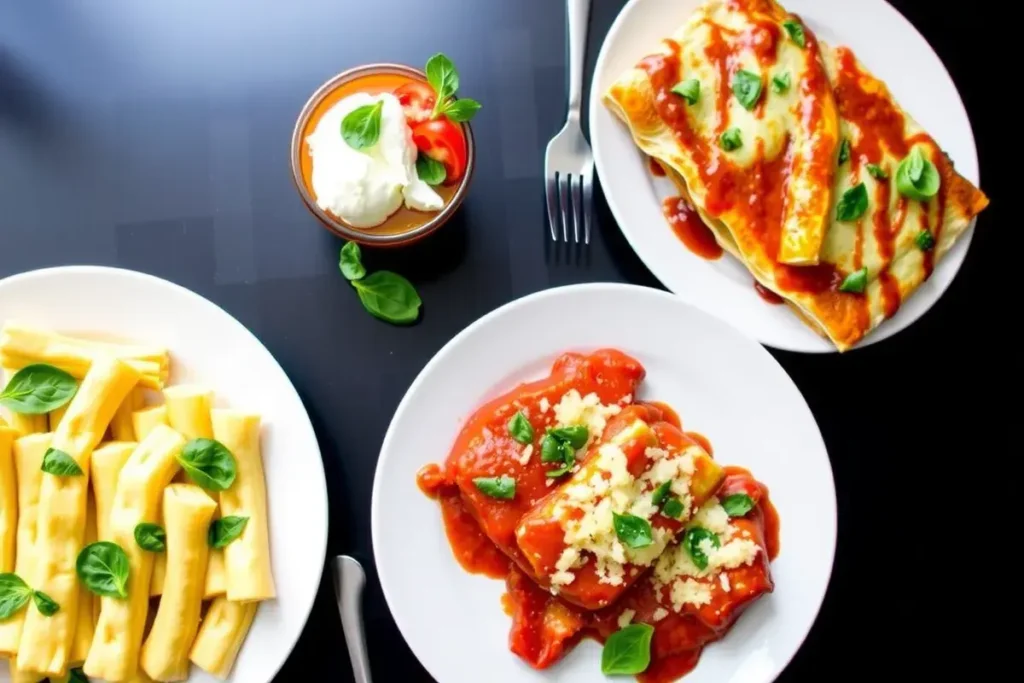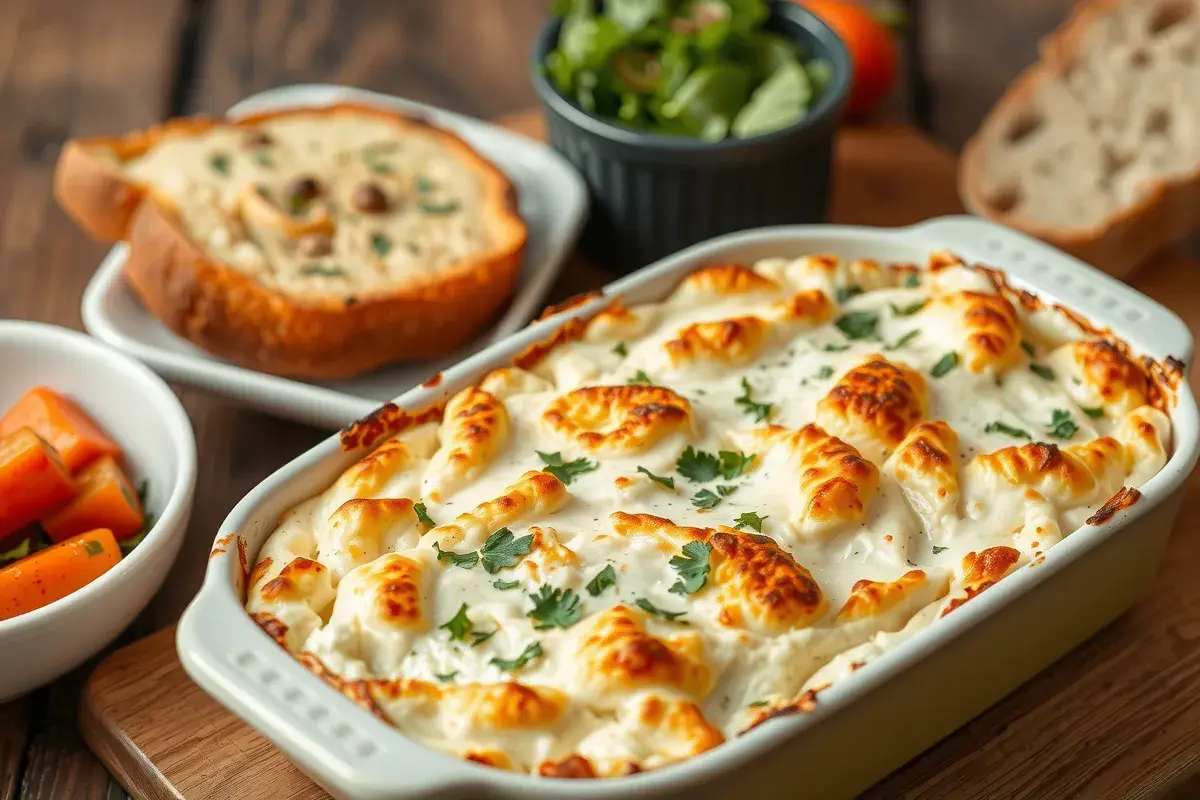Are you searching for a wholesome dish that feels both indulgent and light? Baked cottage cheese may be the answer you’ve been craving. In recent years, cottage cheese has undergone a delightful transformation from a simple refrigerator staple to a creative ingredient in many recipes. However, baked cottage cheese truly stands out, offering a delectable way to enjoy this nutritious dairy product.
In this article, we’ll dive deep into the world of baked cottage cheese and explore why it’s becoming so popular. We’ll uncover its nutritional perks, discuss the best ways to select cottage cheese for baking, and reveal different techniques to get the most satisfying results. Furthermore, we’ll share flavor boosters, recipe suggestions, and serving ideas that will elevate your dining experience. Whether you’re a novice cook or an experienced foodie, baked cottage cheese is an easy yet impressive dish to master.
So, let’s uncover the secrets behind baked cottage cheese. Along the way, you’ll learn how to avoid common mistakes and maximize the deliciousness factor. Ultimately, you’ll be able to craft flavorful creations that rival your favorite restaurant dishes. Enjoy discovering the countless possibilities of this comforting delight, and prepare to be amazed by the effortless elegance of baked cottage cheese.
The Rising Trend of Baked Cottage Cheese in Healthy Eating
Why Baked Cottage Cheese Is Having a Moment
The trend toward mindful and balanced eating has sparked interest in creative ways to prepare traditional staples like cottage cheese. Many people want to enjoy comfort foods without abandoning their nutrition goals. Baked cottage cheese caters to this desire. It combines the creaminess of cheese-based dishes with a lower calorie and fat profile than most popular cheeses. Therefore, it allows health-conscious food enthusiasts to satisfy their cravings in a guilt-free manner.
Moreover, social media has played a pivotal role in spreading the popularity of baked cottage cheese. Platforms like TikTok and Instagram feature short clips of home cooks and professional chefs experimenting with various cottage cheese dishes. Consequently, more adventurous eaters are eager to add these recipes to their culinary repertoire.
A Welcome Alternative to Traditional Cheese Dishes
Cheese often emerges as the hero in comfort-food classics. Nevertheless, many common cheeses, such as cheddar or mozzarella, can be quite high in saturated fat. Baked cottage cheese offers a welcome alternative. It retains a satisfying creaminess without overloading on calories or unhealthy fats. As a result, those looking to lose weight or maintain a specific nutritional plan find it a delicious compromise.
In addition, using cottage cheese in baked meals can cater to different dietary preferences:
- Low-carb diets: Cottage cheese provides protein and fewer carbs, aligning with keto or similar plans.
- Gluten-free diets: Most cottage cheese brands are naturally gluten-free, making them suitable for celiac or gluten-intolerant individuals.
- High-protein diets: Cottage cheese is known for its impressive protein content, which is essential for muscle repair and maintenance.
The Allure of Experimentation
Because baked cottage cheese presents a blank canvas for flavor experimentation, home cooks are drawn to the numerous customization options. For example, you can top baked cottage cheese with caramelized onions, fresh herbs, or savory spices. The mild taste of cottage cheese pairs well with different cuisines—allowing you to craft dishes that range from Italian-inspired casseroles to spicy Southwest-style bakes.
Furthermore, many find the process of baking cottage cheese refreshingly straightforward. All you need are a few ingredients, an oven, and a touch of creativity. Despite its simplicity, the final product looks—and tastes—deceptively gourmet.

Understanding the Nutritional Benefits of Baked Cottage Cheese
The Power of Protein
Cottage cheese stands out for its protein content, which benefits muscle growth and tissue repair. Baked cottage cheese retains this high protein level, making it an excellent post-workout meal or a filling option for those managing their appetite. Moreover, a single serving of cottage cheese usually offers around 13–15 grams of protein, depending on the brand and fat content. Therefore, you can enjoy a hearty portion of baked cottage cheese and feel satiated without feeling weighed down.
Low in Calories and Fat
Many individuals watch their calorie and fat intake for health reasons or to maintain a specific lifestyle. Since cottage cheese is available in various fat levels—full-fat, low-fat, and fat-free—it’s easy to pick a version that suits your goals. Even when you bake cottage cheese, it remains fairly low in total calories compared to other cheese options like gouda or brie.
Furthermore, the baking process itself doesn’t significantly increase the calorie content. Thus, baked cottage cheese is often suitable for those seeking lighter meal options without sacrificing flavor. Indeed, it allows you to indulge in a cheesy dish without consuming excessive saturated fats or a surplus of calories.
Rich in Essential Nutrients
Baked cottage cheese delivers more than just protein. It also contains essential vitamins and minerals:
- Calcium: Critical for bone health and nerve function.
- B Vitamins: Assist in energy metabolism and promote overall wellbeing.
- Phosphorus: Aids in bone formation and maintenance.
Additionally, cottage cheese typically has fewer additives or preservatives than highly processed cheese products. Therefore, you’re more likely to consume a cleaner ingredient profile when choosing cottage cheese for your recipes.
The Role of Sodium
Because cottage cheese can be somewhat high in sodium, it’s best to compare labels and choose a lower-sodium version if that’s a concern for you. Moreover, baked cottage cheese recipes often include fresh or dried herbs, which can offer flavor depth without excessive salt. By using the right seasonings, you can keep sodium content in check and enhance taste naturally.
Quick Tips to Maximize Nutrition
- Opt for low-fat or fat-free cottage cheese if you’re counting calories or saturated fat.
- Look for brands with reduced sodium if needed.
- Supplement your baked cottage cheese dish with vegetables to boost fiber and micronutrients.
- Combine with whole grains (like quinoa or brown rice) for an extra energy source.
Selecting the Ideal Cottage Cheese for Baking

Texture Considerations
When purchasing cottage cheese for a baked cottage cheese recipe, you’ll notice different curd sizes: small, medium, or large. The size of curds can influence texture. Small-curd cottage cheese typically blends more seamlessly into casseroles or bakes, creating a smoother consistency. On the other hand, larger curds add a distinct textural element, which some people prefer for more bite.
Moreover, some brands offer creamed cottage cheese, which is notably richer. Though creamed cottage cheese often tastes more indulgent, it can be higher in fat. Nevertheless, if you’re prioritizing taste and don’t mind slightly higher fat content, creamed cottage cheese might be the right choice.
Fat Content Variations
Cottage cheese is sold in a spectrum of fat percentages:
- Fat-free or skim: Contains no milkfat, an excellent choice if you’re monitoring your fat intake.
- Low-fat: Typically 1–2% fat, providing a balance between richness and calorie control.
- Full-fat: Often around 4% milkfat, ideal for a creamier baked cottage cheese.
Baked cottage cheese will taste creamier with higher-fat varieties, but low-fat and fat-free versions can still yield a palatable dish with proper seasoning or sauce additions. Consider your nutrition goals and mouthfeel preferences when choosing your cottage cheese.
Flavor-Enhanced Cottage Cheese
Some cottage cheese brands offer added flavors or mix-ins, such as chives, pineapple, or strawberry. While fruit-flavored cottage cheese may not be ideal for a savory baked cottage cheese dish, certain herbal or onion-infused varieties can add depth. However, check the ingredient list for extra sodium or additives. If you prefer to maintain complete control over your recipe, plain cottage cheese remains the safest choice.
Points to Remember
- Check curd size: Small curds blend easily, large curds offer more texture.
- Mind your macros: Choose the fat percentage that aligns with your dietary needs.
- Consider additives: Flavored varieties may change the taste and nutrient content of your baked cottage cheese.
- Sodium levels: Look for lower-sodium options to prevent excessive salt intake.
Techniques for Perfectly Baked Cottage Cheese
Preheating and Preparations
For many baked cottage cheese recipes, an oven temperature between 350°F (175°C) and 400°F (200°C) works best. Preheating is essential because it ensures an even cooking environment from the moment your dish enters the oven. Meanwhile, gather essential ingredients such as fresh or sautéed vegetables, eggs, or herbs. Prepare them properly—chop vegetables, whisk eggs, or portion out seasonings—so your workflow remains smooth.
After that, you can grease or line your baking dish. Nonstick spray or a minimal amount of olive oil is enough for most recipes. For an even simpler cleanup, use parchment paper to line the bottom of your casserole dish.
Combining Ingredients
When assembling a baked cottage cheese dish, you want to avoid excessive liquid. Cottage cheese itself has moisture, and adding extra watery ingredients can create a soggy final product. Therefore, if you’re incorporating vegetables with high water content (such as zucchini or spinach), consider sautéing or blanching them first to remove some moisture. This step ensures the final dish doesn’t become soupy.
If you’re making a layered casserole, spread the cottage cheese mixture between layers of other components (like noodles or sliced vegetables). This approach helps the baked cottage cheese meld harmoniously with the rest of the ingredients, resulting in a cohesive and flavorful meal.
Monitoring Baking Time and Doneness
Most baked cottage cheese dishes require 20–40 minutes of baking time, depending on the recipe’s thickness and extra ingredients. Check for doneness by looking for:
- A golden-brown surface or lightly browned edges.
- A firm center that doesn’t jiggle when you gently shake the dish.
- If you insert a toothpick, it should come out clean or with minimal moisture.
However, be cautious not to overbake, as dried-out cottage cheese can become rubbery. Therefore, pay close attention during the final 5 minutes of baking. Once the dish looks or feels done, remove it from the oven and let it rest for at least 5 minutes before slicing or serving.
Enhancing Texture with Broiling
For those craving a crispier finish, switch to the broil function for the final 2–3 minutes. This technique browns the top layer, imparting a slight crunch. However, keep a vigilant eye on the oven during broiling, as the high temperature can burn the dish quickly.
Flavor Boosters and Ingredient Pairings
Herbs, Spices, and Seasonings
Because baked cottage cheese has a mild flavor, it welcomes a plethora of herbs and spices. Use transition words like “however” or “furthermore” to connect ideas. For example:
- Basil and oregano: Perfect for Italian-inspired dishes.
- Cumin and chili flakes: Ideal for a Tex-Mex twist.
- Dill and parsley: Add freshness without overwhelming the cottage cheese’s natural creaminess.
Furthermore, feel free to experiment with spice blends, such as za’atar or garam masala, to infuse distinct global flavors. Always taste your mixture before baking to adjust seasonings accordingly.
Vegetable and Protein Add-Ins
Baked cottage cheese serves as an excellent foundation for nutrient-dense meals. Incorporate a variety of vegetables like bell peppers, onions, mushrooms, or spinach. For instance, sauté mushrooms and onions beforehand to release and concentrate their flavors. Meanwhile, roasted bell peppers add sweetness and color to your dish.
If you prefer extra protein, consider mixing in shredded chicken, turkey, or tofu. Protein additions work especially well in layered bakes or casseroles. For a vegetarian approach, add more hearty veggies like eggplant or sweet potato. These vegetables add richness and bulk, making your baked cottage cheese dish more filling.
Flavor Combination Ideas
- Mediterranean: Combine spinach, sun-dried tomatoes, and oregano.
- Tex-Mex: Include black beans, corn, chili powder, and jalapeños.
- Farmhouse Breakfast: Add scrambled eggs, chopped peppers, and turkey bacon.
- Italian Garden: Mix cottage cheese with pesto, sliced zucchini, and fresh basil.
Sauces and Condiments
Occasionally, you may want a thicker, creamier sauce to bind the baked cottage cheese dish together. In that case, incorporate a small amount of tomato sauce or a homemade white sauce. However, ensure you don’t overdo it; excess liquid can prevent the cottage cheese from setting properly.
Alternatively, top your baked dish with cheese shreds, like mozzarella or cheddar, during the last few minutes of baking. This method creates a mouthwatering, bubbly layer that is sure to impress. Nevertheless, keep in mind this addition will affect the fat and calorie content.
Easy Baked Cottage Cheese Recipes for Every Meal
Even if you have limited kitchen experience, preparing baked cottage cheese is straightforward. Below are a few recipes organized by meal type. Each highlights the adaptability of cottage cheese and shows how it can shine from breakfast through dinner.
1. Breakfast Casserole with Cottage Cheese
- Ingredients:
- 2 cups cottage cheese
- 6 eggs, beaten
- 1 cup chopped veggies (bell peppers, onions)
- 1 cup shredded spinach
- Salt, pepper, and herbs to taste
- Instructions:
- Preheat oven to 375°F (190°C).
- Combine the cottage cheese, beaten eggs, and chopped veggies in a large bowl.
- Season with salt, pepper, and herbs, then stir in shredded spinach.
- Pour the mixture into a greased baking dish.
- Bake for 25–30 minutes or until the center is set.
This recipe pairs well with fresh fruit or whole-grain toast. Therefore, it’s perfect for weekend brunch gatherings.
2. Savory Cottage Cheese Stuffed Peppers
- Ingredients:
- 4 bell peppers, halved and seeds removed
- 1½ cups cottage cheese
- 1 cup cooked quinoa
- 1 cup sautéed mushrooms
- ½ cup diced tomatoes
- ½ teaspoon each of dried basil and oregano
- Instructions:
- Preheat oven to 400°F (200°C).
- Mix cottage cheese, cooked quinoa, and sautéed mushrooms in a bowl.
- Add diced tomatoes and season with basil, oregano, salt, and pepper.
- Stuff pepper halves with the mixture.
- Arrange peppers in a baking dish and bake for 20–25 minutes.
These stuffed peppers make a colorful dinner option. Moreover, you can top them with a sprinkle of mozzarella for an extra cheesy layer.
3. Cottage Cheese Lasagna Bake
- Ingredients:
- 1 pound lean ground turkey (optional for added protein)
- 2 cups marinara sauce
- 2 cups cottage cheese
- 1 egg
- 2 cups fresh spinach
- Lasagna noodles (regular or oven-ready)
- 1 cup shredded mozzarella (optional)
- Instructions:
- Preheat oven to 375°F (190°C).
- Brown the ground turkey in a skillet, then drain excess fat. Stir in marinara sauce.
- In a separate bowl, combine cottage cheese with 1 egg. Add spinach and blend well.
- Layer the lasagna noodles, turkey sauce, and cottage cheese mixture in a greased casserole dish.
- Top with mozzarella if desired, and bake for 30–35 minutes.
It’s advisable to let this lasagna stand for a few minutes before slicing. As a result, it holds its shape and intensifies its flavors.
Serving Suggestions and Presentation Tips
Pairing Baked Cottage Cheese with Side Dishes
Baked cottage cheese often shines as the main star on the dinner table. However, thoughtful side dishes enhance the overall meal. Consider these pairings:
- Roasted Vegetables: Broccoli, Brussels sprouts, or carrots offer complementary textures.
- Whole-Grain Sides: Quinoa, brown rice, or barley lend a balanced, fiber-filled side.
- Fresh Salads: Crisp greens paired with a light vinaigrette bring refreshing contrast.
Furthermore, homemade garlic bread or sourdough rolls can round out a comforting meal. If you want to keep it lighter, a bowl of tomato soup can pair perfectly for a cozy lunch.
Garnishing for Appeal
Simple garnishes can make baked cottage cheese appear restaurant-ready. Here are a few ideas:
- Chopped Fresh Herbs: Sprinkle parsley, chives, or basil on top for a pop of color.
- Toasted Nuts or Seeds: Add crunch with toasted almonds, sunflower seeds, or pumpkin seeds.
- Drizzle of Sauce: Lightly drizzle a balsamic reduction or spicy chili sauce to boost flavor and presentation.
In addition, present your dish in a casserole or gratin dish that is both functional and attractive. Therefore, you can serve directly from the oven to the table, creating a warm and inviting atmosphere.
Storage and Reheating
If you end up with leftovers, baked cottage cheese can maintain its taste and texture for up to three days in the refrigerator. Store it in an airtight container, and reheat in the oven at 350°F (175°C) for approximately 10–15 minutes. For an even quicker approach, use the microwave, though the dish may lose some crispness on top.
Common Mistakes to Avoid When Preparing Baked Cottage Cheese
- Overcooking: Baking for too long results in a rubbery texture. Keep a close eye on the timer, especially during the last few minutes.
- Skipping Preheating: Placing the dish in a cold oven can lead to uneven cooking and subpar consistency. Always preheat for best results.
- Ignoring Excess Liquid: Failing to drain watery ingredients can turn your dish soggy. For example, blanch or sauté high-water-content vegetables first.
- Inadequate Seasoning: While baked cottage cheese is creamy, it’s also mild. Therefore, spices, herbs, and salt are essential to bring the dish to life.
- Choosing the Wrong Cottage Cheese Consistency: If you prefer smooth textures, use small-curd or whipped cottage cheese. Otherwise, large-curd works well if you like a chunkier consistency.
By steering clear of these mistakes, you’ll set yourself up for success. Always remember that each recipe can be tweaked to suit your preferences, so don’t hesitate to experiment with new flavors or cooking methods.
Baked Cottage Cheese FAQ
Does cottage cheese melt when baked?
Cottage cheese doesn’t melt in the same way that cheddar or mozzarella does. Instead, it warms and sets, creating a creamy or slightly firm texture. If you want a gooey layer, add a small amount of a meltable cheese like mozzarella on top during the last few minutes of baking.
Why are people baking cottage cheese?
People are baking cottage cheese because it offers a high-protein, low-calorie alternative to traditional cheese-based dishes. Furthermore, social media trends showcase its versatility and simplicity. As a result, many home cooks are exploring cottage cheese in baked recipes, discovering that it can be both delicious and satisfying.
What happens to cottage cheese when you bake it?
When cottage cheese is baked, the moisture evaporates, and the proteins coagulate. This process creates a firm yet moist result. The texture becomes pleasantly dense rather than stretchy. Because of this quality, baked cottage cheese pairs well with various fillings and seasonings.
Is baked cottage cheese healthy?
Yes. Baked cottage cheese is generally considered healthy due to its high protein content and relatively low fat and calorie levels. Nevertheless, the overall nutritional value depends on the ingredients you add. Thus, opt for lean proteins, whole grains, and plenty of vegetables to keep the dish balanced and nourishing.
Conclusion
Baked cottage cheese is undoubtedly a hidden gem in the world of comfort food. It brings together simplicity, nutrition, and boundless potential for flavor. By selecting the right cottage cheese, using fresh ingredients, and applying foolproof baking techniques, you can transform your home-cooked meals into irresistible creations. Moreover, because baked cottage cheese adapts beautifully to various cuisines and dietary preferences, it’s the ultimate crowd-pleaser.
Whether you’re aiming to cut calories or simply explore a new spin on classic dishes, baked cottage cheese delivers on taste and health benefits. Experiment with herbs, spices, and creative pairings to uncover your favorite combinations. Remember to avoid common mistakes like overcooking or ignoring excess moisture, and you’ll consistently create a top-notch dish. Above all, have fun letting your culinary imagination flourish. Baked cottage cheese might just become a staple in your weekly meal plan, satisfying your cravings while keeping your nutrition in check.

